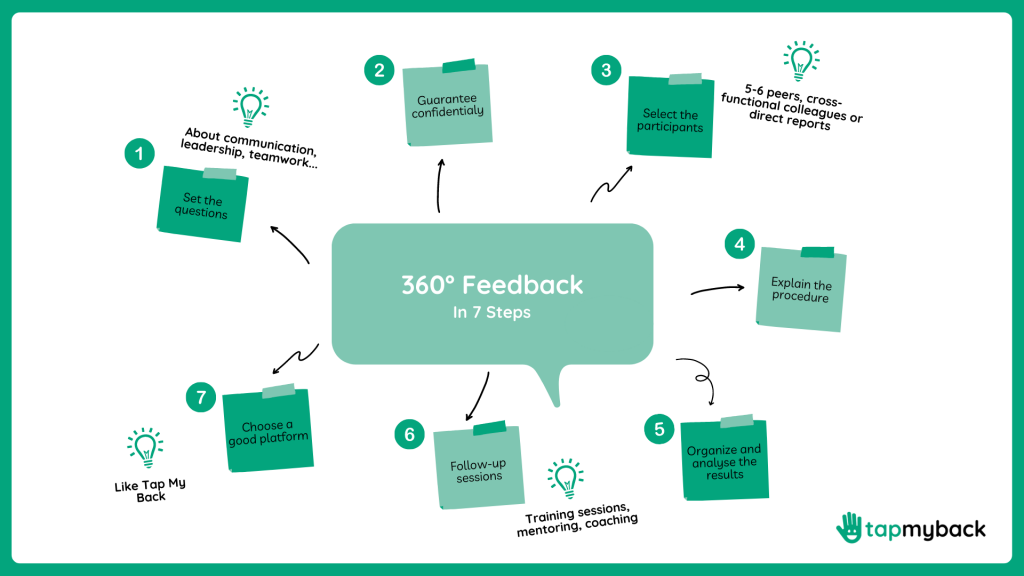How to Implement a 360 Degree Feedback Review
2022-12-03
Struggling to get your employees to participate in your workplace surveys? We’ve listed five solutions you can implement.
What is 360 degree feedback?
Over the years, companies have come to realize the importance of feedback and are increasingly seeking to implement it in their workplaces. There are several ways to implement this process, however, a very interesting method that has been gaining prominence is 360 degree Feedback. 360 degree Feedback allows a team member to be evaluated by collecting feedback, which is usually confidential and anonymous, from colleagues who work directly with him. These can be chiefs, subordinates, or peers, and even the employee himself, using a self-assessment. The main objective is to allow the individuals being evaluated to have a more global view of their skills, strengths, and weaknesses, thus diminishing the possibility of bias that occurs when top-down assessments are made. The colleagues who gave feedback are also responsible for making various assessments over time, to check the progression of the employee, thus benefiting the company. Since this assessment involves people from various levels within the organization, it is expected to provide a more detailed view of each person's needs.
How to develop 360 degree feedback?
Before you start implementing this type of evaluation, it is necessary to consider some relevant aspects, which will help to make this plan more effective. Below you will find the key points that you will need.
1. Set the questions
You should decide which questions you want to be answered, keeping in mind that these should be tailored to each position, taking into account their roles, objectives, and responsibilities. Questions that involve communication, leadership, collaboration, teamwork, time management, creativity, problem-solving may be good examples of skills to assess, as well as questions that refer to the company's values. The answers can be given on a Likert scale of 7 or 5 points, depending on the score differentiation required, or even in an open forum. The questionnaire should not be too long to ensure that employees do not feel bored when filling it out.
2. Guarantee confidentiality
Ensuring anonymity is a priority in this process since participants tend to give more constructive feedback when they are confident that their responses will be anonymous.
3. Select the participants who will answer the questionnaire
These people should be selected with the target employee in mind. This should include 5 to 6 people who should be peers, cross-functional colleagues, or direct reports. Choose enough people to ensure a balanced view of different perspectives and remember to maintain anonymity.
4. Explain the procedure
Discuss with the participants what 360º feedback is and how best to do it. Participants should know how the whole process will unfold, from the collection of responses to the analysis of the results and future follow-up. It is also important to explain how to give good feedback so that it is effective. You can even give examples of what to do and point out the relevance of the assessment. Remind them that they should be honest, that they can feel safe, and that the ultimate goal is to improve the company's performance and their own personal and career development.
5. Organize and analyze
After collecting feedback from all participants, you must analyze the results and decide how you will deliver them. You can choose to make a report of the feedback obtained or to deliver the results personally, working out together strategies to improve some skills.
6. Follow up sessions
After the data obtained from the 360 feedback process has been analyzed, a follow-up should be done to ensure that everything is going well. You can also use training sessions, mentoring, coaching, or workshops to maximize the employee's progress.
7. Choose a good platform
Several online platforms are currently available, which allow you to implement a 360º feedback process in an automated and more fluid way. Undoubtedly, these platforms are game-changers that can guarantee the success of this process. Tap My Back is an option that offers you the opportunity to develop a 360º assessment in a practical way, allowing not only the collection of all the feedback but also a detailed analysis of the data obtained. Our platform also allows you to do skills assessments and automated analytics. Besides this, Tap My Back also has integrations with MS Teams and Slack that make the process flow easier. Check it out here.
The image below can help you consolidate the key points for starting a successful 360 feedback process:
Now that you know the most important aspects to take into account when implementing 360º feedback in your company, it is also necessary to consider the main advantages and disadvantages of this evaluation.
Advantages of 360-degree feedback
More balanced feedback
While annual performance reviews tend to be conducted by directors, which can skew results, 360º feedback offers a holistic view and is less likely to be biased as participants come from various levels of the organization.
It makes it easier to guide the development of employees
By identifying what the employee's strengths and weaknesses are, the employee can more easily understand what they must develop and improve. Once they know what their strengths and weaknesses are, the employee will be able to develop their skills.
Disadvantages of 360-degree feedback
Takes time
The entire process is time-consuming. From formulating the questions to getting the participants together and briefing them on the subject, to putting the process into practice and analyzing the responses. 360-degree feedback involves a great deal of effort on the part of organizations. However, you can count on the Tap My Back skills feedback templates and analytics to facilitate the process.
Focus on weaknesses
If the feedback analysis is not properly done, it can lead to a stronger focus on the weaknesses that have been identified with the employee, instead of also taking into consideration what the employee is already very good at. This can make him feel that he has more negative aspects than positive ones, which can lead to him feeling demotivated. Tap My Back is always focused on improvement and not on criticizing, so it is easier to prevent that from happening.
Conclusions
The 360º feedback can help your company enhance its strengths and improve its weaknesses, after analyzing the responses of your employees, as well as promote better communication, with increased sharing and trust between the various employees. It is important that the implementation of this procedure is well thought out and that it goes through all the points mentioned above, to contribute to the increase in the performance of the organization.
From today onwards misaligned teams and isolated employees can unleash actionable feedback, with the help of Tap My Back.
See More Posts
Platform
Features
Tap My Back @2025. All rights reserved.


